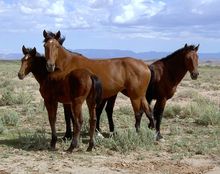University of Saskatchewan (U of S) biologists have made a significant advance in understanding the ecology of Sable Island and its iconic wild horses -- one that underscores how intimately connected living systems are.

Free roaming wild horses
Measurements prove the seals do enrich the island's plant growth with nitrogen from feeding on fish in ocean, and computer modelling has demonstrated that the horses preferentially select those particular grassy areas to eat.
© 2016 by Kersti Nebelsiek
The number of Sable Island horses is at an historic high -- now ranging from 450 to 550 horses compared with only 200 to 400 during the past 250 years. A team led by Philip McLoughlin and Keith Hobson has been trying to find out why the numbers have grown so much.
In research featured this week in the journal Ecology McLoughlin, an associate professor in Biology at the U of S and his team demonstrated a link between burgeoning seal populations on Canada's east coast and the foraging habits of feral horses along the length of Sable Island.
They have found that grey seals, whose numbers on the island have swelled from fewer than 1,000 in the 1960s to nearly 400,000 currently, have their pups on the island and fertilize the sandy, wind-swept grasslands -- transferring nutrients from the sea that promotes growth of the grasses where feral horses have now chosen to feed.
McLoughlin cautions that more research is needed to say definitively whether the increase in seal numbers is increasing the survival and reproduction of the horses feeding near seal colonies. But measurements prove the seals do enrich the island's plant growth with nitrogen from feeding on fish in ocean, and computer modelling has demonstrated that the horses preferentially select those particular grassy areas to eat.
"What is really interesting is that we show how the enrichment of grasses, which occurs non-uniformly on the island, then affects how the horses move around the island to eat," he said.
"This speaks to the question of how seemingly distinct systems -- ocean and land -- can be interconnected by fundamental ecological relationships."
The team's next step is to determine whether nitrogen originating from the sea is detectable in the tissues or hair of the horses and to the extent it explains their reproduction and survival.
He noted the team included U of S graduate students Kenton Lysak and Tom Perry, and post-doctoral fellow Lucie Debeffe.
Since 2007, McLoughlin, his students and his research collaborators have been naming and keeping track of the life histories and movements of every horse that lives on Sable Island, with a view to better understanding how populations function and how isolated populations may be conserved.
"Sable Island is truly one of the most interesting outdoor laboratories a population ecologist could ask for," he said.
The project was funded by the Natural Sciences and Engineering Research Council and the Canada Foundation for Innovation, with in-kind support from Parks Canada Agency and Fisheries and Oceans Canada.
Story Source:
